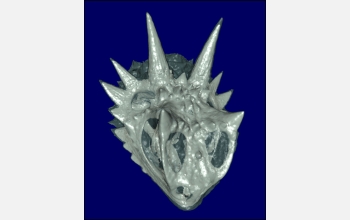Multimedia Gallery
3D head scan of Texas horned lizard showing clear skin and solid bone
A 3D head scan of a Texas horned lizard showing clear skin and solid bone. TThe scan was created at the High-Resolution X-ray Computed Tomography Facility at The University of Texas at Austin.br/>
More about this Image
At the National Science Foundation-supported UTCT, researchers use a nondestructive technique for visualizing features in the interior of opaque solid objects as well as obtain digital information on their 3D geometries and properties.
In this particular visualization application, the external skin and internal skeleton are depicted using a color-mapping scheme that represents the distance from the skin to the bone, giving some of the lizard head reconstruction a polychromatic tie-dyed appearance.
These scans were taken as part of research by Wendy Hodges, a biologist at the University of California, Riverside, who received an NSF postdoctoral fellowship in biological informatics. Hodges is attempting to reconstruct the physical features of the common ancestor of the 13 species of North American horned lizards.
Between 23 and 30 million years ago, the first North American horned lizards branched off from sand lizards, becoming stockier and spinier and evolving their distinctive crowns of horns. A single common ancestor gave rise to the 13 North American species, each developing a unique set of cranial horns and spikes. Researchers are trying to determine what this prehistoric, common ancestor may have looked like and how the horns of these species developed. [Image 8 of 9 related images. (Year of image: 2003)
Credit: Research by Wendy Hodges, Timothy Rowe and Reuben Reyes; X-ray CT scans by High Resolution X-ray CT Facility, Univ. of Texas-Austin, Dept. of Geological Sciences; Specimen courtesy of the Texas Memorial Museum of Science and History; Graphics and 3-D models from Univ. of Texas, Texas Advanced Computing Center, ACES Visualization Lab
Images and other media in the National Science Foundation Multimedia Gallery are available for use in print and electronic material by NSF employees, members of the media, university staff, teachers and the general public. All media in the gallery are intended for personal, educational and nonprofit/non-commercial use only.
Images credited to the National Science Foundation, a federal agency, are in the public domain. The images were created by employees of the United States Government as part of their official duties or prepared by contractors as "works for hire" for NSF. You may freely use NSF-credited images and, at your discretion, credit NSF with a "Courtesy: National Science Foundation" notation.
Additional information about general usage can be found in Conditions.
Also Available:
Download the high-resolution JPG version of the image. (184 KB)
Use your mouse to right-click (Mac users may need to Ctrl-click) the link above and choose the option that will save the file or target to your computer.



 All images in this series
All images in this series